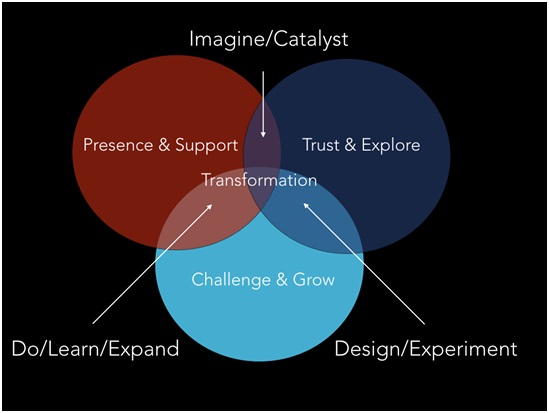A Coaching Model By Tiffany Purn, Career Coach, UNITED STATES
 This is a coaching model for those moving through transition, whether a chosen transition or a transition that has come about as a result of unexpected circumstances. It is also for those who are looking for transformation.
This is a coaching model for those moving through transition, whether a chosen transition or a transition that has come about as a result of unexpected circumstances. It is also for those who are looking for transformation.
This is a circular model, meaning that someone can enter at any point within this cycle – within the coaching process itself and each coaching session. Transformation is always the focal point, however, and we grow by moving through the stages of transformation and change.
The client and the coach each bring values and behaviors to the coaching process that support transition and transformation: presence, support (for the client, an intention to support themselves), trust, willingness to experiment and explore, as well as the willingness to experience challenge and growth. It is the coach’s role to offer all of these at every stage of the journey. It is the client’s role to commit to doing their best, to offering this to themselves, as well, consistently, and in a way that works for them. The magic and transformation that happen with the coach can create a container through example, and the client steps into this container and creates the change and transformation they desire.
The Model Transitions and Transformation

Stage:Imagine/Catalyst
In this stage of transition, we are the beginning of something new. Perhaps we chose this transition (for example: starting a new job, entering into retirement) and perhaps this change found us (for example an unexpected health crisis, unexpected move across the country). We know here that we can’t go back to the past, but the way forward is not clear. This is where we take time to imagine. Where do we want to be in the future? How do we want to move through this next chapter in our life? What we are working towards, and/or what future possibilities might there be? What inspires us?
Stage: Design/Experiment
In this stage of transition, we are in an in-between space. This is sometimes called the void. We cannot yet see what will happen in the future, because we are not the person (or team or organization) that we used to be. This is an important time to either connect to our internal compass if we’re not sure what our internal compass is, to take time to get to know what it is. There is an opportunity in this in-between stage to reorganize, test, experiment, and design new supports as the way becomes more clear. The more we can stay curious, and approach this stage of our journey with an open mind and intentionality, the more we can stay true to our values and vision.
Stage: Do/Learn/Expand
In this stage of transition, we are in action, which can include literal action (taking steps towards the future we envision) but can also include active reflection – learning about what works and what doesn’t, applying that learning and awareness. We adjust as learn, keeping our vision and internal compass in mind, we challenge ourselves to expand, grow, and remain true to our desire to – ultimately – transform. We take risks, and we grow into something we didn’t know was possible before.
This model is intended to mirror the way that life works – in systems, processes, and cycles. It is intended to support people and organizations with a concrete way to navigate the unexpected in a way that can still be intentional and to support longer-lasting, meaningful change.
Learn How to Create Your Own Coaching Model
Your Coaching Model reflects your values,
philosophies and beliefs and must communicate who you will coach
and the problems you will solve. Read more about creating your coaching model